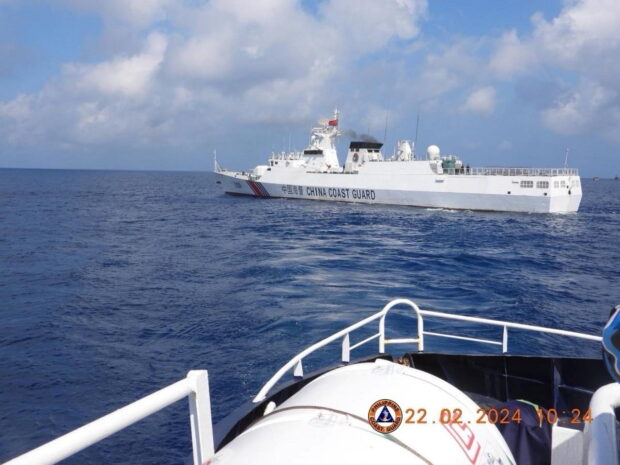PCG: China jamming tracking signal of PH ships in WPS

SIGNAL BLOCKED China Coast Guard (CCG) Vessel No. 3105 sails past BRP Datu Sanday of the Bureau of Fisheries and Aquatic Resources on Feb. 22, when the CCG allegedly blocked the Philippine vessel’s signal. —PHOTO COURTESY OF PHILIPPINE COAST GUARD
The Philippine Coast Guard (PCG) on Sunday accused its Chinese counterpart of jamming the signal of the tracking system of Philippine ships at certain times during recent operations in the West Philippine Sea (WPS), briefly preventing these vessels from broadcasting their positions at sea.
PCG spokesperson for the West Philippine Sea Commodore Jay Tarriela said they observed during the rotational deployments this month by PCG and Bureau of Fisheries and Aquatic Resources (BFAR) ships at Bajo de Masinloc (Scarborough Shoal) that “there were instances” that the vessels could not transmit their automatic identification signals (AIS).
“We assume that they do the jamming every time they release their statements that they repelled our vessels,” he told reporters, without providing evidence.
The AIS transmits a vessel’s position so that they could be identified and located by other ships. They are also trackable through ground stations and satellites.

‘Press release’
At around 8 a.m. on Feb. 22, the China Coast Guard (CCG) allegedly blocked the AIS of BFAR’s BRP Datu Sanday, which was deployed to supply fuel and ensure the security of Filipino fishermen, “to support China’s press release of successful ‘repelling’ of Philippine state vessels” in Bajo de Masinloc, Tarriela noted.
Around an hour later, the “CCG released a statement through their official website that they have repelled BRP Datu Sanday when it illegally intruded into waters adjacent to China’s Huangyan Dao,” Tarriela said, referring to the Chinese name for the shoal.
A few minutes after this incident, the Chinese state-backed mouthpiece Global Times posted the English translation of the CCG statement on social media, he added.
“We also noticed this occurrence during the last deployment of BRP Teresa Magbanua and BRP Datu Tamblot. Through such jamming, any commercial AIS monitoring cannot also disprove such statements because they may not be able to find our vessels,” Tarriela explained.
The PCG’s BRP Teresa Magbanua and BFAR’s BRP Datu Tamblot were deployed early this month for the first rotational deployment at Bajo de Masinloc.
Constant shadowing
China and the Philippines have engaged in aggressive information warfare in recent weeks as they both assert sovereign rights in the South China Sea.
Bajo de Masinloc, a rich fishing ground off Zambales province, is a small ring of reefs located within the country’s exclusive economic zone (EEZ). In 2012, China seized control of the shoal after a tense standoff with the Philippine Navy, prompting the Philippine government to file a case against it before the international arbitration court.
On July 12, 2016, an international arbitral tribunal hearing the Philippines’ case against China in the South China Sea ruled in favor of the Philippines, deciding that China’s claims—including its nine-dash line, recent land reclamation activities and other activities in Philippine waters—were unlawful. China has refused to recognize the ruling.
During last week’s rotational deployment at Bajo de Masinloc, a CCG vessel and three other Chinese ships tried to block BRP Datu Sanday, while a helicopter deployed from a People’s Liberation Army (PLA)-Navy vessel flew overhead within the country’s territorial airspace, Tarriela said.
Three of these Chinese ships came as close as 100 meters of the Philippine vessel, while floating barriers were also deployed at the southeast entrance of Bajo de Masinloc to prevent Filipino fishermen from coming closer.
READ: PH Coast Guard ship’s signal jammed while on West Philippine Sea patrol
“Despite these maneuvers, the skipper of BRP Datu Sanday exhibited excellent seamanship skills and managed to evade the blocking attempts. Throughout the mission, the BFAR was closely monitored by the shadowing Chinese vessels,” Tarriela said.
Radio challenges were also exchanged throughout, with both asserting territorial claims. The BRP Datu Sanday responded to all the 28 radio challenges issued by the CCG.
Three PLA-Navy vessels were also in support of the Chinese coast guard and militia ships within 25 nautical miles from the shoal and it “did not approach the territorial sea limits,” Tarriela added. INQ